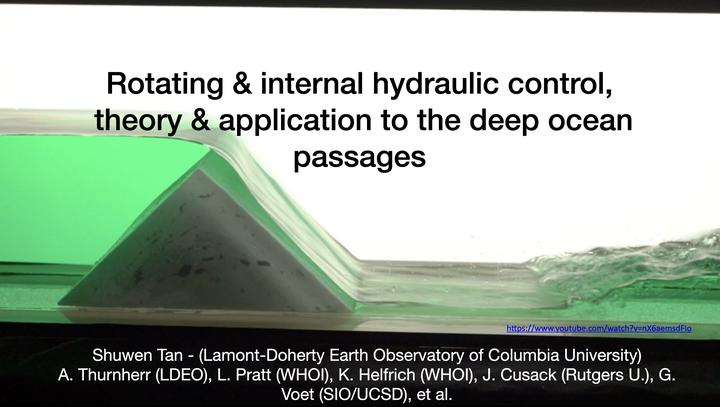 Image credit: Recording
Image credit: RecordingAbstract
As a flow passes over a sill or through a topographic saddle point, given adequate upstream conditions, it is possible that the flow is hydraulically controlled, meaning the structure and transport of the flow are regulated by the topography. The lower limb of the Meridional Overturning Circulation (MOC) passes a number of passages where it is under hydraulic control. The hydraulic theory can thus serve as a tool to 1) estimate the structure and transport of flow without taking direct velocity measurements; 2) monitor the change of the MOC. This talk starts with a brief overview of the hydraulic theory, emphasizing the fundamentals and two flavors of hydraulic control: 1) for a rotating flow; 2) for a stratified flow. This leads to the second and third parts of the talk, each contains a theory study and an example of application to the MOC. In the second part, a rotating hydraulic control theory is proposed to estimate the transport partition of an inflow that splits into two passages, one being hydraulically controlled and the other is not. An application is the Antarctic Bottom Water carried by the MOC entering the Samoan Passage in the Southern Pacific Ocean, where it is hydraulically controlled, while the remainder is diverted around the Manihiki Plateau and is not controlled. A numerical model is employed to explore novel features of hydraulic control under the Earth’s rotation and verify the necessity of friction along the uncontrolled passage for a persisting hydraulic control in the other passage. In the third part, hydraulic theory for a continuously stratified flow with a strongly stratified interface is proposed to explore how the change in upstream stratification affects hydraulic control. The theory is applied to the lowing interface and the reducing magnitude of the stratification profile upstream of the Samoan Passage from the 1990s to the 2010s. We note similar decadal changes in stratification upstream of the Vema Channel connecting the Argentine and the Brazil Basins and a deep fracture zone canyon in the eastern Brazil Basin have been found from repeated hydrographic observations and similar interpretation can be made from hydraulic theory.